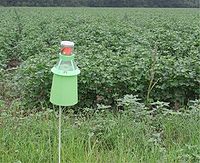
Photo from wikipedia
Invasive insects cost the global economy around USD 70 billion per year. Moreover, increasing agricultural insect pests raise concerns about global food security constraining and infestation rising after climate changes.… Click to show full abstract
Invasive insects cost the global economy around USD 70 billion per year. Moreover, increasing agricultural insect pests raise concerns about global food security constraining and infestation rising after climate changes. Current agricultural pest management largely relies on plant breeding—with or without transgenes—and chemical pesticides. Both approaches face serious technological obsolescence in the field due to plant resistance breakdown or development of insecticide resistance. The need for new modes of action (MoA) for managing crop health is growing each year, driven by market demands to reduce economic losses and by consumer demand for phytosanitary measures. The disabling of pest genes through sequence-specific expression silencing is a promising tool in the development of environmentally-friendly and safe biopesticides. The specificity conferred by long dsRNA-base solutions helps minimize effects on off-target genes in the insect pest genome and the target gene in non-target organisms (NTOs). In this review, we summarize the status of gene silencing by RNA interference (RNAi) for agricultural control. More specifically, we focus on the engineering, development and application of gene silencing to control Lepidoptera through non-transforming dsRNA technologies. Despite some delivery and stability drawbacks of topical applications, we reviewed works showing convincing proof-of-concept results that point to innovative solutions. Considerations about the regulation of the ongoing research on dsRNA-based pesticides to produce commercialized products for exogenous application are discussed. Academic and industry initiatives have revealed a worthy effort to control Lepidoptera pests with this new mode of action, which provides more sustainable and reliable technologies for field management. New data on the genomics of this taxon may contribute to a future customized target gene portfolio. As a case study, we illustrate how dsRNA and associated methodologies could be applied to control an important lepidopteran coffee pest.
Journal Title: International Journal of Molecular Sciences
Year Published: 2022
Link to full text (if available)
Share on Social Media: Sign Up to like & get
recommendations!